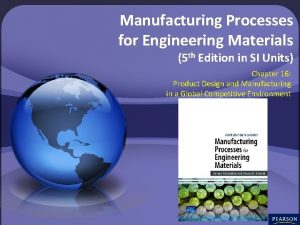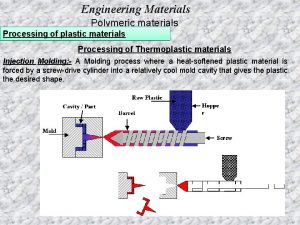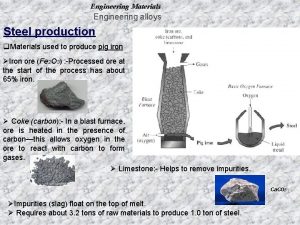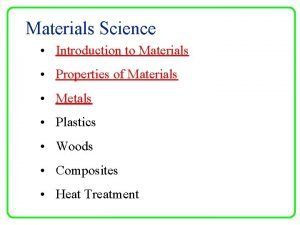INTRODUCTION TO ENGINEERING MATERIALS REV00 Sept 2017 MATERIALS





















- Slides: 21

INTRODUCTION TO ENGINEERING MATERIALS REV-00 (Sept 2017)

MATERIALS SCIENCE AND ENGINEERING �Materials science involves investigating the relationships that exist between the structures and properties of materials. �Materials engineering involves, on the basis of these structure–property correlations, designing or engineering the structure of a material to produce a predetermined set of properties

�The role of a materials scientist is to develop or synthesize new materials, �Whereas a materials engineer is called upon to create new products or systems using existing materials and/or to develop techniques for processing materials.

INTERRELATIONSHIP AMONG PROCESSING, STRUCTURE, PROPERTIES, AND PERFORMANCE Three thin disk specimens of aluminum oxide that have been placed over a printed page in order to demonstrate their differences in light transmittance characteristics. The disk on the left is transparent (i. e. , virtually all light that is reflected from the page passes through it), whereas the one in the center is translucent (meaning that some of this reflected light is transmitted through the disk). The disk on the right is opaque—that is, none of the light passes through it. These differences in optical properties are a consequence of differences in structure of these materials, which have resulted from the way the materials were processed.

WHY STUDY MATERIALS SCIENCE AND ENGINEERING? �In design and manufacturing: Materials problem is one of selecting the right material from the thousands available. �The selection based on several criteria: 1) The in-service conditions must be characterized, for these dictate the properties required of the material. 2) Consideration is any deterioration of material properties that may occur during service operation 3) The overriding consideration is that of economics: What will the finished product cost?

CLASSIFICATION OF MATERIALS � Metals are composed of one or more metallic elements (e. g. , iron, aluminum, copper, titanium, gold, nickel), and often also nonmetallic elements (e. g. , carbon, nitrogen, oxygen) in relatively small amounts. � Relatively dense in comparison to the ceramics and polymers. � Mechanical characteristics, these materials are relatively stiff and strong, yet are ductile (i. e. , capable of large amounts of deformation without fracture), and are resistant to fracture, which accounts for their widespread use in structural applications. � Metals are extremely good conductors of electricity and heat (Metallic materials have large numbers of non-localized electrons). � Not transparent to visible light. In addition, some of the metals (i. e. , Fe, Co, and Ni) have desirable magnetic properties.

� Ceramics are compounds between metallic and nonmetallic elements; they are most frequently oxides, nitrides, and carbides. � For example, common ceramic materials include aluminum oxide (or alumina, Al 2 O 3), silicon dioxide (or silica, Si. O 2), silicon carbide (Si. C), silicon nitride (Si 3 N 4), and, in addition, what some refer to as the traditional ceramics—those composed of clay minerals (e. g. , porcelain), as well as cement and glass. � Mechanical behavior, ceramic materials are relatively stiff and strong—stiffnesses and strengths are comparable to those of the metals and typically very hard. Historically, ceramics have exhibited extreme brittleness (lack of ductility) and are highly susceptible to fracture.

�Ceramic materials are typically insulative to the passage of heat and electricity (i. e. , have low electrical conductivities. �More resistant to high temperatures and harsh environments than are metals and polymers. �Optical characteristics, ceramics may be transparent, translucent, or opaque �Some of the oxide ceramics (e. g. , Fe 3 O 4) exhibit magnetic behavior.

�Polymers include the familiar plastic and rubber materials. Many of them are organic compounds that are chemically based on carbon, hydrogen, and other nonmetallic elements (i. e. , O, N, and Si). �Some common and familiar polymers are polyethylene (PE), nylon, poly(vinyl chloride) (PVC), polycarbonate (PC), polystyrene (PS), and silicone rubber. �These materials typically have low densities, �Mechanical properties—they are not as stiff or strong, extremely ductile and pliable (i. e. , plastic), which means they are easily formed into complex shapes.

�Polymer are relatively unreactive in a large number of environments. �One major drawback to the polymers is their tendency to soften and/or decompose at modest temperatures, which, in some instances, limits their use. �Low electrical conductivities and are nonmagnetic.

� A composite is composed of two (or more) individual materials that come from the categories previously discussed—metals, ceramics, and polymers. � The design goal of a composite is to achieve a combination of properties that is not displayed by any single material and also to incorporate the best characteristics of each of the component materials. � Some naturally occurring materials are composites— for example, wood and bone. � Synthetic (or human-made) composites. Some of examples: GFRC (Glass fiber reinforced composite; CFRC (Carbon fiber reinforced composite)

� One of the most common and familiar composites is fiberglass, in which small glass fibers are embedded within a polymeric material (normally an epoxy or polyester). The glass fibers are relatively strong and stiff (but also brittle), whereas the polymer is more flexible. Thus, fiberglass is relatively stiff, strong, and flexible. In addition, it has a low density � The carbon fiber–reinforced polymer (CFRP) composite—carbon fibers that are embedded within a polymer. These materials are stiffer and stronger than glass fiber–reinforced materials but more expensive. CFRP composites are used in some aircraft and aerospace applications, as well as in high-tech sporting equipment.

Bar chart of room temperature density values for various metals, ceramics, polymers, and composite materials.

Bar chart of room temperature stiffness (i. e. , elastic modulus) values for various metals, ceramics, polymers, and composite materials.

Bar chart of room temperature strength (i. e. , tensile strength) values for various metals, ceramics, polymers, and composite materials.

ADVANCED MATERIALS � Semiconductors have electrical properties that are intermediate between those of electrical conductors (i. e. , metals and metal alloys) and insulators (i. e. , ceramics and polymers) � Biomaterials are employed in components implanted into the human body to replace diseased or damaged body parts. These materials must not produce toxic substances and must be compatible with body tissues (i. e. , must not cause adverse biological reactions).

�Smart (or intelligent) materials are a group of new and state-of-the-art materials now being developed that will have a significant influence on many of our technologies. The adjective smart implies that these materials are able to sense changes in their environment and then respond to these changes in predetermined manners Just People Imagination !!! Reality in Design and Fabrication!!! STENT

� Nanomaterials, which may be any one of the four basic types— metals, ceramics, polymers, or composites. However, unlike these other materials, they are not distinguished on the basis of their chemistry but rather their size; the nano prefix denotes that the dimensions of these structural entities are on the order of a nanometer—as a rule, less than 100 nanometers (nm; equivalent to the diameter of approximately 500 atoms).

SUSTAINABLE MATERIAL �Issues in GLOBAL PERCEPTIVE-ON GOING WORK �Challenging to concerning on the SOURCES, ENVIRONMENTAL IMPACT, HUMAN HEALTY EFFECT, DESIGN or APPLICATION ASPECT, NEW PROPERTIES, RECYCLING EFFORTS

Student Activities / Homework �What is materials science and engineering? �What we need to consider in material selection process? �What is advantages and disadvantages for each engineering materials?

Density (g/cm^3)
 Un deux trois quatre cinq six sept huit
Un deux trois quatre cinq six sept huit La guerre de sept ans
La guerre de sept ans Candide ou l optimisme
Candide ou l optimisme How many hills in jerusalem
How many hills in jerusalem Dessin poésie le blaireau sans gêne
Dessin poésie le blaireau sans gêne Ecrivez les sept jours de la semaine
Ecrivez les sept jours de la semaine Sept commandements
Sept commandements Cnn 10 september 7
Cnn 10 september 7 Sept heure moins le quart
Sept heure moins le quart Damon poole
Damon poole Ectomy examples
Ectomy examples Sept
Sept I sept
I sept Sept comme setteur questionnaire
Sept comme setteur questionnaire Transnet engineering tenders 2017
Transnet engineering tenders 2017 Natural materials and man made materials
Natural materials and man made materials Title useful and harmful materials at home
Title useful and harmful materials at home Natural man made
Natural man made Adopting materials
Adopting materials Direct materials budget with multiple materials
Direct materials budget with multiple materials Manufacturing processes for engineering materials 5th
Manufacturing processes for engineering materials 5th Heat conductivity examples
Heat conductivity examples









































